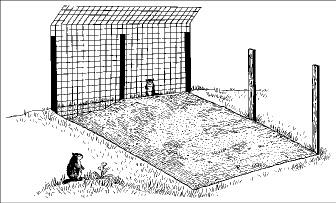Vegetable Gardening (125 page)

Figure 17-7:
Build a fence to keep out woodchucks and raccoons, making sure to keep the top 18 inches unattached to the stakes.
Chapter 18: Containing Your Veggies
In This Chapter
 Choosing the right size and type of container
Choosing the right size and type of container
 Taking a look at potting soil
Taking a look at potting soil
 Finding the best vegetables to grow in pots
Finding the best vegetables to grow in pots
 Planting and caring for container-grown vegetables
Planting and caring for container-grown vegetables
 Getting the scoop on greenhouses, hoop houses, and hydroponics
Getting the scoop on greenhouses, hoop houses, and hydroponics
You can grow almost any vegetable in a container; just fill a big pot with good soil, plant your chosen veggies, and then water and fertilize regularly. Why not just grow vegetables in your garden? Well, maybe you aren't a farmer with a big backyard and a 10-horsepower rototiller. Maybe your soil is more appropriate for raising worms than raising plants. Or maybe your garden is the balcony of your apartment or a tiny patio behind your condominium. You still have the right to fresh, homegrown tomatoes, don't you? You bet, and containers enable you to grow them.
Containers also enable you to grow vegetables that may not be able to grow successfully in your garden. For example: If you've tried to grow eggplant in a climate with cool summers, but it never matured before the first frost, try growing it in a container. Because containers heat up fast in spring, vegetables get a head start on the season.
Some people grow vegetables in containers simply because they like having their crops nearby — I certainly do. With containers, you can bring your crops close to your house where you can see and enjoy them (and eat them at the peak of freshness!). Because containers are so easy to move (or because you made them that way by putting them on wheels), containers are the great equalizer; if you need a little more or less sun, you simply move the containers. (It's a heck of a lot easier than moving the sun!) Similarly, if frost is threatening, you can move the containers to shelter.
Vegetables can be beautiful; I've seen pots of vegetables that are every bit as colorful as my favorite flowers. Whew, I'm getting excited about growing vegetables in containers! And that's what this chapter is all about: discovering how to get a bountiful and beautiful vegetable harvest from containers.
Considering a Few Container Characteristics
One trip to a nursery gives you an idea of just how many different styles and types of containers you can choose from. You can buy clay pots, glazed or not; plastic pots, pretty or ugly; or wood pots, big or small. And that's just the tip of the iceberg. Here are some things to keep in mind when choosing a pot for vegetables:
 Size:
Size:
In most cases, pots that are bigger (in terms of width and volume) are better, especially for growing large plants like tomatoes. Lots of root space means that your vegetables are less likely to get cramped; they'll also be easier to water and fertilize. If you want to grow one head of lettuce in a small pot (8 inches in diameter), for example, you can do it, but you'll have to water and fertilize more frequently than if you had grown it in a larger pot. Although I've grown tomatoes in 5-gallon containers, I prefer at least the 15-gallon size.
With some vegetables, the depth of a container is as important — if not more important — as its width. You can grow quite a few carrots or radishes in a narrow container, but the container must be deep enough to accommodate the length of the plant's mature roots. See the section "Knowing Which Vegetables Grow Well in Pots," later in this chapter, for more on size issues for specific vegetables.
A half whiskey or wine barrel is a large, inexpensive container that can hold quite a few vegetables — ten heads of lettuce, ten bush bean plants, one or two small tomato plants, or four or five small cucumber varieties. You can purchase these containers at garden centers and nurseries.
 Material:
Material:
What a pot is made of can affect how often you have to water and how long the container lasts. Pots made of porous materials like clay dry out faster than those made of plastic or wood, so you must water the plants in them more frequently, especially in hot or windy climates.
 If you want to use wood containers, make sure they're made of rot-resistant materials like cedar or redwood; otherwise, they won't last very long. I prefer not to use preservative-treated wood containers for growing vegetables or other edibles, because the chemicals may leach into the soil and then into my plants. If my redwood or cedar pots eventually rot after 10 years, I just replace them — the same goes for my half whiskey barrels.
If you want to use wood containers, make sure they're made of rot-resistant materials like cedar or redwood; otherwise, they won't last very long. I prefer not to use preservative-treated wood containers for growing vegetables or other edibles, because the chemicals may leach into the soil and then into my plants. If my redwood or cedar pots eventually rot after 10 years, I just replace them — the same goes for my half whiskey barrels.

 Drainage:
Drainage:
All the pots you use for growing vegetables should have drainage holes; fortunately, almost all do. But because a wooden half barrel often doesn't, you have to drill your own holes in the bottom of the container (eight to ten evenly spaced, 1-inch holes should be fine). If pots don't have drainage holes, the soil becomes a swampy mess, the roots drown, and the plants die. Bummer.

